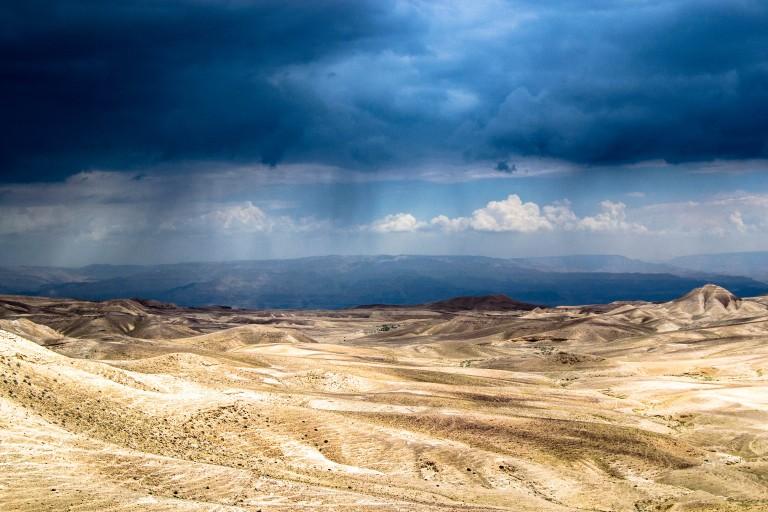If you think about the desert, you most probably will imagine Bedouins and dunes, an unwelcoming place were the heat is unbearable, where there is no water to quench your thirst nor shadows to seek for repair. In the desert you will answer the call of both danger and adventure. If you will exit from Jerusalem and go East towards the Jordan and the Dead Sea, you will be faced by Judas’ Desert, where Jesus was tempted by the devil. We will tell you a story about this harsh place in summer turning to green pastures the rest of the year. This is the desert where many biblical and evangelic episodes take place, a desert that has been inhabited way longer before the Bible tells, as many archaeological finds can confirm.
The first human inhabitants
Jericho is one of the most important cities funded in Judas’ desert with Bethlehem, Gush Etzion and Hebron. It is considered the most ancient city in the world and it sits right in the center of the desert on the so called Tell es-Sultan, north-west from the modern city center. The first village is a primitive one and dates to the 8000 BC (Mesolithic period) whilst the first fortifications were built in the 7000 BC (Neolithic). Initially identified as the biblical walls destroyed by Joshua, they are far older. Recently scholars hypothesized and astronomical use for the 9 meter high stone made tower of the walls.
Some of the most interesting findings dating to the first urbanization period are some plastered skulls with shell replacing the eyes of the dead. It is a very ancient form of cult of the ancestors and foundation ritual as the skulls were found buried under the floor of the houses their spirits were supposed to protect. The first city was abruptly left by its inhabitants in the 4000 BC, probably because of a catastrophic event and was rebuilt in the Bronze Age. The many trunks used in the construction of the walls suggest that this now harsh place was once lush and rich in trees.
Another tragic event is behind one of the most intriguing but less known archaeological discovers in the Holy Land: the treasure of Judas’ desert. The hoard dates back to the 3500 BC (Copper Age) and was found in 1961 in a straw mat tucked under a rock in a cave nearby the seasonal river of Nahal Mishmar, nearby Hebron. It consisted of 442 copper, bronze, stone and ivory objects: 240 axe heads, 100 scepters, 5 crowns, some powder horns, tools and weapons finely decorated with horned animals theories.
The treasure was surveilled by 20 skeletons, whose broken bones and blood stained bandages, preserved by the arid desert climate, lead scholars thinking they were a group of refugees escaping and hiding the hoard from a violent attack to the contemporary Temple of Ein Gedi. The Temple, only 11 km away, was found completely empty, with no votive and ceremonial objects whatsoever. The treasure can be admired in a Hall of the Israeli Museum in Jerusalem.
The roman domination: Herod the Great and the first anchorite monks
Jericho and other villages were rebuilt by the Hyksos, enemies of the Egyptians, and then were under the control of the Persians. Although, the most profound signs in the landscape were left by the romans. Herod the Great, the man behind the bloody massacre of the innocents (see Mt 2, 6-18) and, therefore, one of the most hated man while alive and even when dead, decided to build a winter fortress with external reinforcements and a mausoleum on the top of the “Paradise Mount” nearby Bethlehem. His final resting place was probably identified in 2007 at the entrance of the Herodion palace. It might be a marble building brutally vandalized already in the past.
Going South from the Herodion you’ll land in the Chariton Wadi, where Saint Chariton founded the first “lavra”, a small monastic settlement, in 345 AC. One of the most famous monasteries of the Byzantine Era, whose first units where usually identified in a cave system where the anchorite eremites (those who “go in the desert”) found shelter, is the Quarantine Mount Monastery. Today we link the term “quarantine” to the current Covid pandemic and it usually assumes a negative meaning but Mont Quarantine refers to the 40 days of lent and abstinence that Jesus took in the very Judas’ desert. According to the tradition, this is the “very high mount” where Jesus was “led by the Spirit into the desert to be tempted by the devil” for the first time.
We want to end our imaginary journey in the desert in this special place during the first week of Lent, here where the Gospel leads you this Sunday.


















